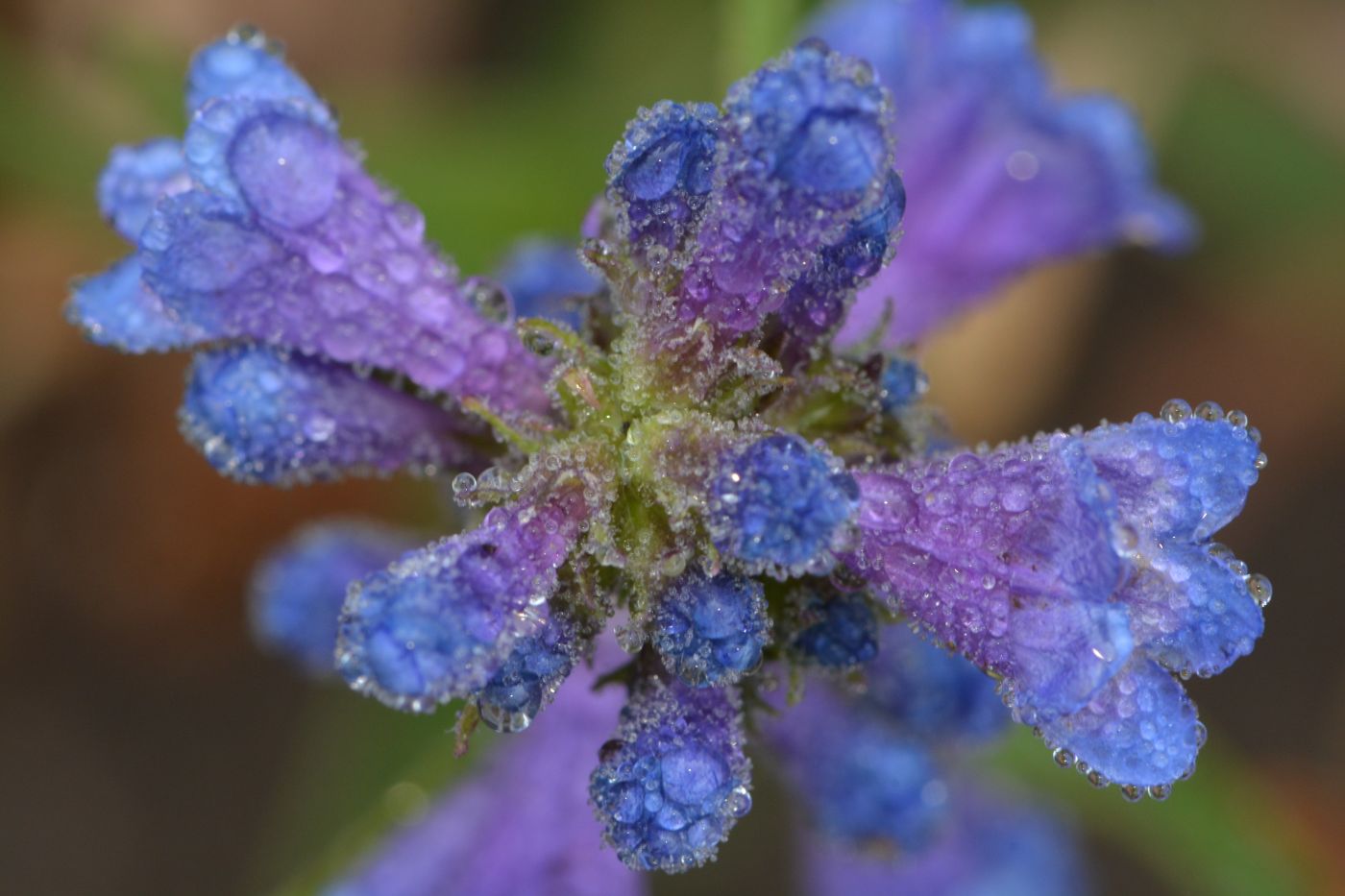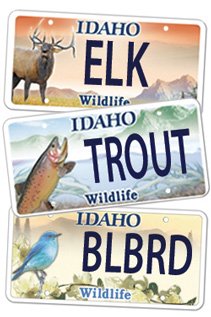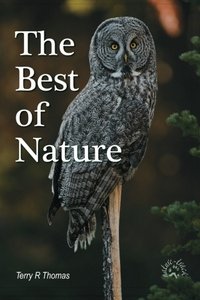Water part 2

Drops of water cling to this penstemon because of two special properties of water: cohesion and adhesion.
After a rain shower in Copper Basin near Mackay, I emerged from our tent to see what had changed. With the sun now shining, branches, leaves, and wildflowers all glimmered in rain droplets still clinging to them, creating tiny gems on every surface. This seemed like a perfect time for a little photography so I picked up my camera and tripod and headed out. I was soaked in short order, but the show was fabulous so I didn’t mind. Water droplets, from those as large as a pea to smaller than the head of a pin, covered everything.
Had this been alcohol, gasoline or just about any other liquid, this would not have happened. That is because water, that oh so common, yet essential element, has a number of properties that make it unique. Two of these are called cohesion and adhesion. Cohesiveness is the tendency of water molecules to cling to each other. Water has a higher cohesive factor than any other non-metallic liquid. Water sticks to itself and because of this and the resulting high surface tension, can form droplets instead of spreading out. Adhesion is the ability to stick to other things, and again, water excels at this, sticking to a huge variety of objects, flowers and leaves among them.
Water is also called the universal solvent, not because it can dissolve everything, but because it can dissolve more compounds than any other solvent. It does this with its strong polarity (positive and negative ends). Think about dumping salt (NaCl) into water. It doesn’t take long for the salt crystals to disappear. While the eye cannot see it, the positive side of the water molecules are pulling at the negatively charged chlorine atoms while the positive side of the water molecules are pulling at the sodium atoms. Salt always loses this tug-o-war, breaking into sodium and chloride atoms surrounded by water molecules.
This ability to be a super solvent is of great consequence to life on Earth. In its pure state, water has a pH of 7 and cannot even conduct electricity. However, water dissolves many of the elements it passes through adding minerals, chemicals, and nutrients that are essential for life. This occurs inside as well as outside our bodies.
Water helps with just about every function of the body, but here are a few highlights. Blood, for instance, is mostly water. This water surrounds dissolved molecules and transports them throughout the body. Nutrients such as proteins, sugars, amino acids, vitamins, and minerals are all transported in the blood.
Waste products such as urea and unwanted chemicals build up inside the kidneys and liver. Water dissolves these elements and flushes them from the system. Severe dehydration (not drinking enough water) can lead to acute kidney problems within a couple of days as these wastes build up.
Many chemical reactions occur each day within our bodies. Even the most basic of these occur in a water medium or require water as part of the reaction.
Water also acts as a cushion for many of our organs and joints. Cerebrospinal fluid that protects our brain and spinal cord? Mostly water. Synovial fluid? This protects and lubricates our joints and is mostly water. Amniotic fluid, that soft cushion we all rested in while waiting for birth? Yup. Mostly water.
Water also helps with thermo-regulation. As mammals, our bodies thrive within a very narrow temperature range. Too hot or too cold and essential processes stop and we perish. Water has a high heat capacity meaning that it takes a lot of outside energy to change the temperature of water even a little bit. Think about putting a pot of water on a stove burner set to high. It might take 30 seconds to change the temperature of that water just a degree or two. What would happen to your hand or a block of wood on that same burner for 30 seconds? Water evens out the highs and lows much more efficiently, keeping us at our 98.6 degree F. optimal temperature.
This is all making me thirsty. I think I’ll have a Diet Dew, or better yet, a glass of water.
Help Idaho Wildlife
When we traveled across the state in October 2017, we visited most of the Idaho Department of Fish and Game wildlife management areas. Most of the vehicles we saw using the wildlife management areas did not have wildlife plates. Buying wildlife plates is a great way for non-hunters and hunters alike to support wildlife-based recreation like birding.
C'mon folks, let's help Idaho's wildlife by proudly buying and displaying a wildlife license plate on each of our vehicles!
See below for information on Idaho plates. Most states have wildlife plates so if you live outside Idaho, check with your state's wildlife department or vehicle licensing division for availability of state wildlife plates where you live.
And tell them that you heard about it from Nature-track.com!

Wildlife License Plates
Great news! as of 2024, there are three NEW designs for license plates. They still are bluebird, cutthroat trout and elk, but they are beautiful.
Idaho Wildlife license plates provide essential funding that benefits the great diversity of native plants and wildlife that are not hunted, fished or trapped—over 10,000 species or 98% of Idaho’s species diversity. Game species that share the same habitats (such as elk, deer, antelope, sage-grouse, salmon, trout) also benefit from these specialty plates.
No state tax dollars are provided for wildlife diversity, conservation education and recreation programs. Neither are any revenues from the sale of hunting or fishing licenses spent on nongame species. Instead, these species depend on direct donations, federal grants, fundraising initiatives—and the Idaho Wildlife license plates.
Both my vehicles have Bluebird Plates. I prefer the bluebird because the nongame program gets 70 percent of the money from bluebird plates, but only 60 percent of the money from elk and trout plates - 10 percent of the money from elk plates supports wildlife disease monitoring and testing programs (to benefit the livestock industry) and 10 percent from cutthroat plates supports non-motorized boat access.
Incidentally, in 2014, the Idaho Legislature denied the Department of Fish and Game the ability to add new plates or even to change the name of the elk and cutthroat plates (very specific) to wildlife and fish plates, a move that would have allowed for changing images occasionally and generating more revenue. It would seem that they believe that we Idahoans don't want a well funded wildlife program.
I think it is time we let the Legislature know that Idahoan support wildlife funding and that we would like to see these generic plates come to fruition.

"WOW. What a phenomenal piece you wrote. You are amazing." Jennifer Jackson
That is embarrassing, but actually a fairly typical response to my nature essays. Since The Best of Nature is created from the very best of 16 years of these nature essays published weekly in the Idaho Falls Post Register (online readership 70,000), it is a fine read. It covers a wide variety of topics including humorous glimpses of nature, philosophy, natural history, and conservation. Readers praise the style, breadth of subject matter and my ability to communicate complex and emotional topics in a relaxed and understandable manner.
Everyone can find something to love in this book. From teenagers to octogenarians, from the coffee shop to the school room, these nature essays are widely read and enjoyed.
Some of the essays here are my personal favorites, others seemed to strike a chord with readers. Most have an important message or lesson that will resonate with you. They are written with a goal to simultaneously entertain and educate about the wonderful workings of nature. Some will make you laugh out loud and others will bring a tear to the eye and warm your heart.
Readers Write:
"You hit a home run with your article on, Big Questions in Nature. It should be required reading for everyone who has lost touch with nature...great job!" Joe Chapman
"We enjoyed your column, Bloom Where Planted. Some of the best writing yet. The Post Register is fortunate to have your weekly columns." Lou Griffin.
To read more and to order a copy, click here or get the Kindle version
Copies are also available at:
Post Register
Island Park Builders Supply (upstairs)
Barnes and Noble in Idaho Falls
Harriman State Park, Island Park
Museum of Idaho
Valley Books, Jackson Wyoming
Avocet Corner Bookstore, Bear River National Wildlife Refuge, Brigham City, Utah
Craters of the Moon National Monument Bookstore, Arco, Idaho